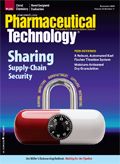Insider Solutions: A New Direction for USP?
With a five-yar revision cycle around the corner, USP will hit or miss the collaboration mark.
The United States Pharmacopeia (USP) held its Annual Scientific Meeting in Toronto in September. At the meeting, USP released a series of whitepapers (all seven are available at www.usp.org) that discuss the role the pharmacopeia's public standards play in an "era of healthcare crisis and reform" (1, 2).

Susan J. Schniepp
USP's Council of the Convention (CoC) assembled the whitepapers. Established in 2005 to facilitate and educate United States Pharmacopeial Convention (USPC) representatives, CoC is responsible for examining the purpose, role, and composition of USPC membership, including voting procedures. These responsibilities are critical to defining a revision cycle. A revision cycle is defined as the five-year period between conventions in which the Expert Committees set standards (i.e., develop and revise monographs and general chapters) of the USPC. Convention representatives are responsible for selecting USP committee chairs and voting on the resolutions that will define USP's strategic direction. The 2010 convention will take place Apr. 21–24, 2010, in Washington, DC, and the 2010–2015 revision cycle will commence on July 1, 2010.

(Stockbyte/GETTY IMAGES)
A bit of history
Envisioned as a liaison between USP's Council of Experts, scientific staff, and convention members, CoC also holds responsibility for reviewing with key stakeholders the progress on resolutions adopted at annual meetings. These annual interactions are expected to result in a more educated membership that is prepared to deal with the complex issues facing USP when all parties meet at the convention every five years. USPC meets every five years to set the goals, objectives, and direction for USP during the upcoming revision cycle.
USP was founded in 1820, long before the pharmaceutical industry came into existence. At that time, medicines were prepared by pharmacists, making them the pharmaceutical manufacturers of the day. Because of this and other historical developments, USPC membership is based heavily in the pharmacy community. The pharmaceutical industry is represented in USPC by trade organizations such as the Generic Pharmaceutical Association, the Parenteral Drug Association, and the Pharmaceutical Research and Manufacturers of America. Each member organization sends a representative to the convention, where he or she is expected to vote on changes to the USP Constitution and bylaws, select (by vote) the members of the Board of Trustees as well as the Council of Experts Chairs, conduct business meetings, debate, and vote on resolutions.
The upcoming convention
Fast forward to September 2009 when CoC released seven whitepapers at the USP Annual Scientific meeting. The seven papers address areas of interest for USP (e.g., food ingredients and dietary supplements), but three are of special interest to the pharmaceutical industry, as summarized below.
Whitepaper: "USP's Role in Setting Enforceable Quality Standards for Medicines." The content of this CoC whitepaper discusses USP's ongoing mission to establish standards for all pharmaceutical products approved for sale in the US. According to this paper, USP's monograph universe consists of 5720 articles. Of these 5720 products, 1960 (34%) do not have monographs and 583 (10%) have monographs that do not meet current standards and need to be updated. The paper justifies the out-of-date monographs by stating that, "USP has no way to compel information and receipt of candidate materials to support a public monograph." The paper further indicates that the US Food and Drug Administration's Freedom of Information Act prevents USP from obtaining the necessary information to establish monographs from companies' new drug and abbreviated new drug applications. The paper explains some of the efforts undertaken to establish missing monographs, including establishing performance-based monographs (3) and developing monographs from existing sources outside the US. In addition, CoC explores USP's potential role in supply-chain management to prevent economically motivated adulteration through the convention's standards-development process.
Whitepaper: "Importance of Standards in Assuring Good Quality Food Ingredients and Foods." During the 2005–2010 revision cycle (August 2006), USP purchased the Food Chemicals Codex (FCC) from the Institute of Medicine (IOM). In February 2008, under the auspices of USP, the sixth edition was published, followed by supplements in February 2009 and August 2009. USP also established a web-based publication, the FCC Forum, for users to review and comment on proposed changes to FCC monographs. This whitepaper indicates that the industry has been slow to respond to the standards in FCC and discusses potential avenues for enhancing the use and prestige of the FCC on a global basis.
The pharmaceutical industry uses the FCC because it contains monograph information for some common ingredients that are used in drug-product formulation but that are not subjects of USP monographs. The industry needs to monitor the international activities of the FCC to ensure they are consistent and appropriate.
Whitepaper: "USP's Role in Assuring Global Access to Quality Medicines." During the 2005-2010 revision cycle, USP made concerted efforts to expand its global presence. This whitepaper describes USP's current international efforts and identifies possible ways to advance this initiative. One unique concept presented in this white paper is a proposal to establish an independent Global Health Care Secretariat as a means to secure and control global registrations of products and medicines. As stated in the paper, this initiative would be "based in a vision of a collaborative global health care secretariat with multiple components, involving representatives from all countries and yielding decisions suitable for national adoption. The components would focus on a) discovery, b) research and development, c) sound regulatory decision-making and, when appropriate, rapid registration decisions, d) optimal pricing–payment strategies, e) evidence-based healthcare delivery based on outcomes/pharmacoeconomic studies, f) quality of care, and g) safe medication use."
Summing it up
What does all of this mean? In April 2010, USPC will convene and vote on resolutions that will effect the next five years of USP activities. These whitepapers may set the stage for those votes. It is important for industry to read these papers in their entirety and be prepared to engage in debate on the pros and cons during the open-floor discussion of the convention. This is the best way to assure that USP will appropriately represent all parties of the pharmaceutical-products process, and it may be your best opportunity to influence the direction of USP as it strategizes the next five years.
Many of the ideas brought forth in these whitepapers appear to be altruistic. It is hard to argue with the concepts of securing safe food, providing safe medication, and establishing appropriate standards for the global community. However, other organizations such as the International Conference on Harmonization and the Pharmaceutical Inspection Cooperation Scheme are trying to address many these same issues. It would seem appropriate for USP to engage them in dialogue so that efforts are not duplicated and to prevent a divergent set of standards from evolving.
Susan J. Schniepp is vice-president of quality assurance at Javelin Pharmaceuticals, 125 CambridgePark Drive, Cambridge, MA 02140, tel. 617.499.4709, sschniepp@javelinpharma.com
References
1. USP whitepaper, USP's Role in Patient Safety, Sept. 23, 2009.
2. USP whitepaper, Opportunities for Drug Information and Use Standards, Sept. 23, 2009.
3. Performance-based Monographs, Pharmacopeial Forum 35 (3), 2009, 765–770.

Pharmaceutical Tariffs Are Imminent: How Industry is Bracing for Impact
April 16th 2025On April 14, 2025, the Trump Administration launched a national security-driven investigation into pharmaceuticals, a move that will likely result in tariffs being placed on pharmaceutical drugs, ingredients, and other components that are imported from outside of the United States.